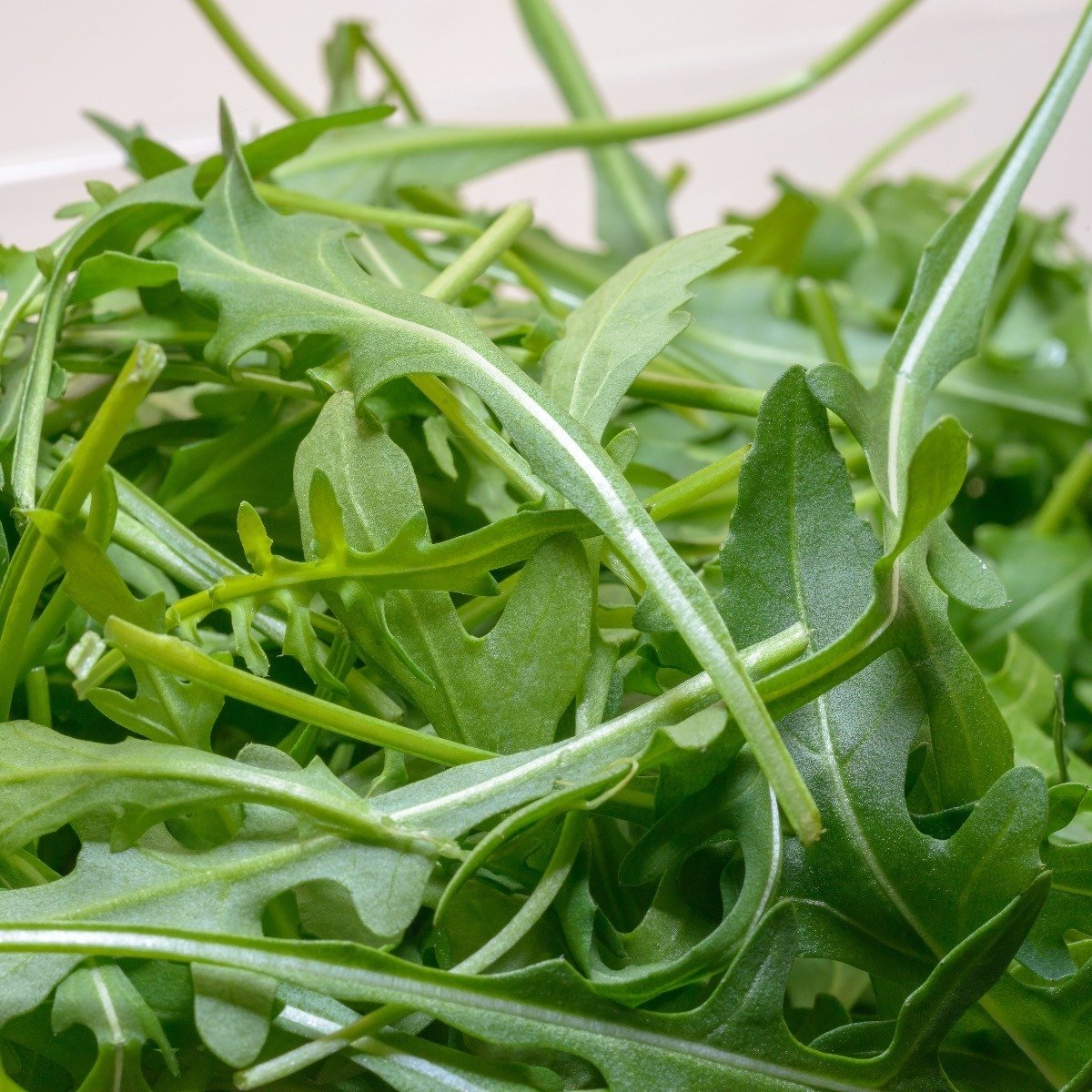Everything You Need to Know About Arugula
We love arugula in our house. It is not something my mom ever served us as kids growing up in New Jersey. My dad would have called it a weed. I can’t image my brother, sister, or I enjoy it as our side salad. We grew up on iceberg lettuce.
I’m not sure when arugula became popular and mainstream, but it has, and there is so much to love about it. This post provides you with lots of exciting information about arugula and answers some questions you may have.
Arugula
Arugula, also known as rocket or roquette, is a leafy green vegetable member of the Brassicaceae family, including other popular vegetables like broccoli, cauliflower, and cabbage. It has been enjoyed for centuries and is a staple ingredient in Mediterranean and Middle Eastern cuisines. The plant is native to the Mediterranean region but has now spread to other parts of the world, including North America.
Arugula is a versatile vegetable that can be eaten raw or cooked. It has a slightly peppery and bitter taste, which makes it a popular addition to salads and sandwiches. However, the bitterness is reduced when cooked, and the vegetable has a slightly nutty flavor that pairs well with various dishes.
Nutrition
One of the most significant benefits of arugula is its nutritional content. It is an excellent source of vitamins A, C, and K, as well as calcium, potassium, and iron. These nutrients are essential for maintaining good health and can help prevent chronic diseases such as cancer, heart disease, and osteoporosis. Additionally, arugula is low in calories and high in fiber, making it an excellent choice for those looking to maintain a healthy weight.
Arugula is packed with antioxidants, which help protect the body from damage caused by free radicals. Free radicals are unstable molecules that can cause cellular damage, leading to inflammation and disease. Antioxidants work by neutralizing these molecules, preventing them from causing harm to the body.
How to Enjoy Arugula

One of the most popular ways to enjoy it is in salads. It adds a unique flavor and texture to any salad and pairs well with other ingredients. Some popular salad combinations include arugula, pear, blue cheese, feta, and cherry tomatoes. Arugula can also be added to sandwiches, pizzas, and wraps for an added burst of flavor.
It is also an excellent addition to pasta dishes. Its slightly bitter taste pairs well with rich tomato or creamy Alfredo sauces. Add arugula to your next pasta dish for a unique flavor and added nutritional value.
Arugula can also be used in other dishes, such as soups, stews, and omelets. It can be added at the end of cooking to prevent it from becoming too wilted and to maintain its flavor and texture.
One unique use for it is to make pesto. Traditional pesto is made with basil, but arugula can be used as a substitute or added to the traditional recipe for a unique twist. Arugula pesto is a delicious addition to pasta dishes or can be used as a dip for vegetables or crackers.
Because it is relatively easy to grow and can be grown in garden beds and containers, it prefers cooler temperatures and does well in partial shade or full sun. It is a fast-growing plant that can be harvested in as little as four weeks after planting. The leaves can be harvested individually or cut back entirely to encourage new growth.
Five Fun Facts About Arugula
- Arugula was once considered an aphrodisiac: Arugula was believed to have aphrodisiac properties by the ancient Romans and Egyptians. Its Latin name, “Eruca sativa,” is derived from the Latin word for “caterpillar” because it resembles the insect, also believed to be an aphrodisiac.
- It is also known as “rocket”: Arugula has several names, including rocket, roquette, and rucola. The name “rocket” is believed to have originated from the Italian word “cola,” which is the name for arugula in Italy.
- It is a cool-weather crop: it prefers cooler temperatures and grows best in the spring and fall. It can be grown in the summer but may bolt or go to seed in hot weather. In some regions, arugula can be grown year-round if protected from frost.
- It is a common ingredient in Italian cuisine: Arugula is often added to pasta dishes, pizzas, and salads. In Italy, it is commonly served with Parmesan cheese, olive oil, and lemon juice.
- It is easy to grow: it is a fast-growing plant that can be grown in garden beds, containers, or even as a microgreen. It prefers well-draining soil and partial shade or full sun. The seeds can be sown directly into the soil or started indoors and transplanted outside. Arugula can be harvested as soon as four weeks after planting.

Why Do Some People, Like My Dad, Call It a Weed?
Arugula is sometimes referred to as a weed because it can grow easily and quickly in specific environments, especially in areas with cool and moist climates. It is known to be a hardy plant that can thrive in a variety of soil conditions and can even tolerate some shade. As a result, it can sometimes grow spontaneously in gardens, fields, and other open areas, leading some people to view it as an unwanted weed.
While some people may view arugula as a weed, many others appreciate its unique flavor and nutritional value and actively seek it out in grocery stores and farmers’ markets. Whether you see it as a weed or a valuable food source, arugula is an exciting and versatile plant that can be a fun addition to any garden or kitchen.
Types of Arugula
There are several different types of arugula, each with a unique flavor and appearance. Some of the most popular types of arugula include:
- Regular Arugula is the most common type that you will find in grocery stores and farmers’ markets. It has long, green, serrated leaves and a slightly peppery taste.
- Wild Arugula, or “sylvetta,” is a smaller and more delicate type often used in salads. It has a slightly bitter and nutty flavor.
- Baby Arugula is harvested when the leaves are still young and tender, resulting in a more delicate and less peppery flavor than regular arugula.
- Wasabi Arugula has a spicy and pungent flavor similar to wasabi. It is often used as a garnish or added to sushi rolls and other Japanese dishes.
- Red Veined Arugula has dark green leaves with red veins running throughout. It has a slightly bitter taste and can be used in salads or garnish.
- Italian Arugula, or “rugola,” has a milder and sweeter taste than regular arugula. It is often used in Italian cuisine, such as pizzas and pasta dishes.
- Dragon’s Tongue Arugula has long, thin leaves with a red vein running down the center. It has a slightly sweet and nutty flavor and is often used in salads or as a garnish.
- Astro Arugula has a milder and less peppery flavor than regular arugula. It has large, dark green leaves and is often used in salads and sandwiches.
- Slow Bolt Arugula is a variety that is less likely to bolt or go to seed in hot weather than other types. It has a slightly spicy flavor and is often used in salads and as a garnish.
These are just a few examples of the many types of arugula available. Each type has its unique flavor and appearance, making it a versatile and exciting ingredient to experiment with in the kitchen.
What Is the Most Common Arugula Used In Salads?

The most commonly used type in salads is regular arugula. Regular arugula, also known as salad arugula, has long, green, serrated leaves and a slightly peppery taste that adds a nice flavor to salads. Its slightly bitter taste also makes it a great complement to sweeter salad ingredients, such as fruit or honey mustard dressings.
Baby arugula is another popular choice for salads, especially for those who prefer a milder and less peppery flavor. It is harvested when the leaves are still young and tender, resulting in a more delicate texture and flavor than regular arugula.
However, there are many different types of arugula, and each variety can be used in salads depending on personal preference and the other ingredients in the salad. For example, wild arugula, or sylvetta, has a slightly bitter and nutty flavor that pairs well with citrus fruits. In contrast, Italian arugula has a milder and sweeter taste that is great in salads with grilled meats or roasted vegetables.
Do People Eat It Cooked?
Yes, it can be cooked, adding a unique flavor and texture to many dishes. Here are some examples of how arugula can be cooked:
- Sauteed Arugula: Heat some olive oil in a pan and add minced garlic. Once the garlic is fragrant, add a bunch of arugula and cook until the leaves are wilted. Season with salt and pepper to taste, and serve as a side dish or on top of toast.
- Pesto: Replace basil with arugula in a classic pesto recipe for a peppery twist. Blend arugula, garlic, pine nuts, Parmesan cheese, and olive oil until smooth, and use it as a pasta sauce, spread, or dip.
- Soup: Saute some chopped onion and garlic in a pot, add vegetable broth and chopped arugula, and simmer until the arugula is tender. Blend the soup until smooth and season with salt, pepper, and lemon juice.
- Pizza: Top pizza dough with tomato sauce, mozzarella cheese, and arugula, and bake until the crust is crispy and the cheese is melted. Drizzle with balsamic glaze and serve hot.
- Risotto: Add chopped arugula to your favorite risotto recipe during the last few minutes of cooking for a fresh and peppery flavor. Finish with Parmesan cheese and lemon zest.
- Omelet: Whisk together eggs and arugula, and cook in a pan with butter or olive oil until set. Add some goat cheese or feta cheese and fold it in half. Serve with toast or a salad on the side.
What to Look For When Purchasing?

When buying arugula, there are a few things you should look for to ensure that you are getting the freshest and highest quality:
- Appearance: Look for arugula with bright green leaves that are crisp and not wilted. Avoid yellow or brown leaves, a sign of age or spoilage.
- Smell: It should have a fresh, peppery smell. It may be past its prime if it has a strong or unpleasant odor.
- Texture: The leaves should be firm and tender. Avoid any with tough or stringy stems, as these can be unpleasant to eat.
- Packaging: Look for arugula sold in a tightly sealed bag or container to ensure freshness. Check the expiration date and buy it with the most extended shelf life.
- Organic: Consider buying organic if possible. This will ensure that the arugula is grown without synthetic pesticides or fertilizers.
- Source: If you have a choice, consider buying arugula locally or from a trusted supplier. This will ensure it is fresh and handled correctly during transportation and storage.
How Should You Store It?
- First, remove any rubber bands or twist ties from the arugula leaves.
- Rinse the leaves under cold running water to remove dirt or debris. Gently pat the leaves dry with a clean towel or use a salad spinner to remove excess water.
- Place the leaves in a large resealable plastic bag or an airtight container. If using a plastic bag, squeeze out as much air as possible before sealing it.
- Store it in the refrigerator in the crisper drawer, which is the coldest part of the fridge.
- If it starts to wilt or become limp, refresh it by soaking the leaves in a bowl of cold water for a few minutes, then patting them dry.
Arugula is best for the freshest flavor and texture within a few days of purchasing it. Avoid storing arugula with fruits such as apples and bananas, as these can release ethylene gas that can cause the arugula to spoil faster.
How Long Will It Last in the Refrigerator?
Arugula is a delicate leafy green that can wilt and spoil quickly, so it is essential to store it properly to maximize its shelf life. Here are some tips for storing it in the refrigerator:
- Moisture: Arugula must be stored in a cool, moist environment to prevent drying. Wrap it in a damp paper towel or place it in a plastic bag with a damp paper towel to help retain moisture.
- Airflow: it must be stored in a well-ventilated environment to prevent it from getting too damp or developing mold. Do not pack the arugula too tightly in the refrigerator; avoid storing it in a sealed container.
- Temperature: it must be stored at a cool temperature to prevent it from wilting or spoiling. Store it in the refrigerator’s crisper drawer, which is the coldest part of the fridge.
Arugula can last up to five days in the refrigerator with proper storage. However, using it as soon as possible is best to enjoy its fresh, peppery flavor and prevent it from spoiling.
What Greens Are Similar to Arugula?
If you cannot find arugula or do not like its peppery taste, there are several greens that you can use as a substitute. Here are some options:
- Watercress has a slightly peppery taste and a similar texture. It is an excellent substitute for salads or a garnish for soups and sandwiches.
- Baby spinach has a mild taste and a tender texture, making it a versatile substitute for arugula in salads and sandwiches.
- Kale has a slightly bitter taste and a sturdy texture, which makes it an excellent substitute for arugula in cooked dishes such as soups, stews, and stir-fries.
- Mustard greens have a strong, spicy flavor similar to arugula. They can be used in salads or cooked dishes such as quiches or stir-fries.
- Radicchio’s slightly bitter taste and sturdy texture make it an excellent substitute for arugula in salads. It is also commonly used in Italian cuisine.
- Endive has a slightly bitter taste and a crisp texture, making it an excellent substitute for arugula in salads. Its small, curled leaves also make it a visually appealing garnish.
Remember that each of these greens has a unique taste and texture, so the dish’s flavor may vary slightly depending on the substitute used.

Where Does Most of the Arugula in the United States Come From?
Most of the arugula consumed in the United States is grown domestically, with California being the primary source of arugula production. According to the USDA National Agricultural Statistics Service, California produces more than 90% of the country’s arugula, followed by Arizona and New Jersey.
California’s mild climate and fertile soil provide optimal growing conditions for arugula. As a result, most arugula production occurs in the state’s central and southern regions, including the Salinas and Santa Maria Valleys, where large-scale farming operations grow arugula alongside other leafy greens and vegetables.
In addition to domestic production, arugula is also imported from countries such as Italy, Spain, and France, where it is a popular ingredient in traditional cuisine. However, most arugula consumed in the US is grown locally, allowing consumers to enjoy the freshest and most flavorful.















